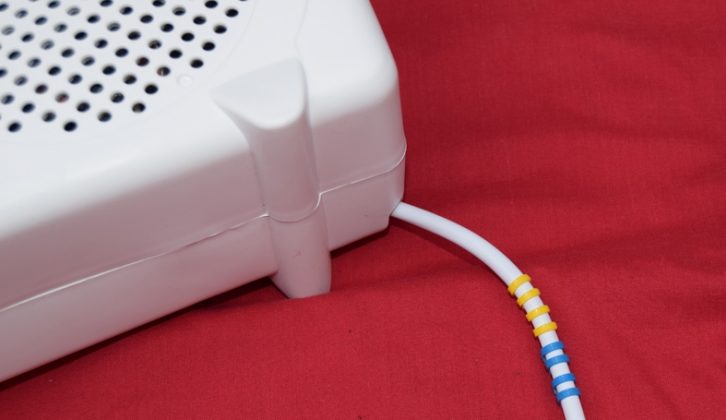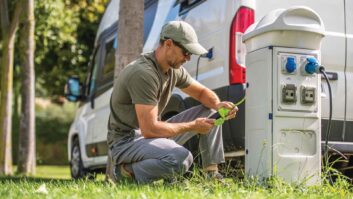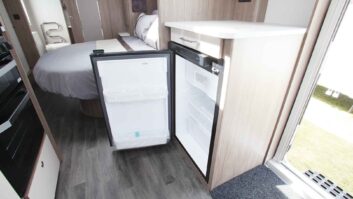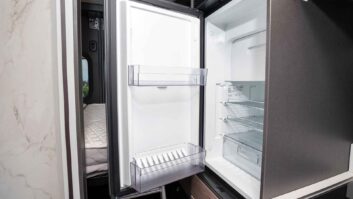For many motorcaravanners, choosing where we stay in our ‘van will be influenced, at least in part, by whether we will be able to hook up to mains power.
Increasingly, we’ve come to expect all of the comforts of home when we tour – a microwave, electric space heating and a fridge/freezer are just some of the ‘essentials’.
But unlike home, we don’t have the same mains supply capacity, and if not heeded, this can cause problems. On two recent trips, site neighbours have approached me with the age-old question: “Has your power gone off?”
Sometimes the supply itself has gone down, but more often than not, they have exceeded the current delivery capacity of the hook-up and the overcurrent trip has activated.
Although normally it’s just a case of re-engaging the trip switch by the connecting point, there are times when it is a bit more complicated; for example, when the rain is coming down in sheets or, as was the case for one of my enquirers, the current trips were housed centrally in a locked cabinet and reception wasn’t due to open until the following morning.
You can fit load-monitoring systems (see Practical Motorhome July 2016), but as I’ll explain here, with some basic understanding of power supply and consumption, problems can be avoided without having to fit such devices.
Campsite hook-up
Most European hook-ups provide 230V AC via a blue three-pin 16A socket; the UK three-pin types follow close behind. Each hook-up usually has a miniature circuit breaker (MCB) devoted to each outlet. This displays the current rating limit, above which, it will trip out.
MCB current ratings vary between sites. The controlling factors range from such things as the capacity of the supply wiring to the campsite, or the site owner using a low rating to keep electricity charges to a minimum.
The norm is 10A, with 6A close behind, although I have also seen many 3A MCBs on Italian sites.
So what does all this mean? In real terms, it pays to know what loading you will subject the hook-up point to, to avoid the dubious delight of waking up to a defrosted fridge one morning.
All it takes for this to happen is the thermostatically controlled 2kW space heater kicking in at the same time as the thermostatically controlled 1kW water heater, after you have gone to bed. The resulting 13.5A demand with trigger the 10A hook-up to trip.
Power budgets
The various appliances we use all have a power rating, expressed in watts. To calculate watts, multiply the voltage applied by the resulting current in the appliance used:
Volts x Amps = Watts
By transposing this formula, we can arrive at a value for current drawn, using the declared power rating and the supply voltage:
Watts + Volts = Amps
Amps are monitored by the hook-up trip. As an example, a typical travel hairdryer is a 230V device with a power rating of 1000W (1kW). Using our formula, we can work out the current drawn by the hairdryer as follows:
1000 + 230 = 4.35 Amps
The same formula applies to all of the other appliances in use. Normally, each has a plate or label giving its wattage rating; in some cases, the actual current drawn will also be given.
If you use more than one appliance, the collective wattage is additive – that is, if you run a 1kW hairdryer at the same time as a 1kW kettle, you are consuming 2kW from the hook-up. The current taken has also doubled and will stand at 8.7A (4.35 + 4.35).
Now, whereas at home we can plug in what we want whenever we want (within reason), hook-ups have a current limit – so it pays to know what is available and what you are using, if you are to avoid trudging through the mud on a rainy night to re-engage the hook-up trip.
Simple reminders
To keep things simple, I say that with 4A flowing, an appliance can be classed as being, roughly, a 1kW device.
As an easy reminder of this, I put four small cable ties around the supply wire of any 1kW appliances I use.
I’ve taken a similar approach with any other appliance that we plug into the mains (two cable ties for 500W, eight cable ties for 2kW and so on).
This means that, as I use different appliances, all I have to do is add up the total number of cable ties. Then as soon as they start to approach nine, in the case of a 10A hook-up MCB (see item two below), I am made aware that a ‘blackout’ is approaching.
I then have the option of drying my hair after I have made myself a cup of tea and heated my take-away in the microwave, thereby saving myself a miserable trip to the hook-up post to restore the power.
Certain items, such as space heaters, have a dual power rating, depending on which switched heating level is selected by the user.
In this case, I use the appropriate number of cable ties on one colour for the first setting, and a different colour for the second setting. If the higher setting is used, all of the cable ties should be included in the count.
However, it should be noted that there are a couple of important caveats to this approach:
1 Background appliances, such as water heaters and fridge/freezers controlled by thermostats, might kick in at any time, so their power rating needs to be ascertained and allowed for in your calculations.
2 As stated above, 1kW actually draws 4.35A, so with two appliances of 1kW power rating in use, there will be just over 8.7A flowing, leaving only 1.3A (or 300W) until a 10A MCB in the hook-up would trip out.
So, as a rule of thumb, a 10A supply would handle up to a total of nine markers, with a small margin of spare capacity. A 6A supply would handle a count of five, and so on.
In general terms, the main current ‘guzzlers’ are electrical appliances that produce heat, such as hairdryers, kettles, cooker rings, water heaters, microwaves and space heaters.
The likes of radios, TVs and phone and tablet chargers only draw small currents when on the mains, so can generally be ignored.
Finally, it should be noted that microwaves often have two power ratings. One is the ‘radiated’ power (which does the cooking) and the second (higher) figure is the ‘overall’ power used. It is the latter rating that should be considered in your power budget calculations.
On two recent trips, site neighbours have approached me with the age-old question: " Has your power gone off?"





















